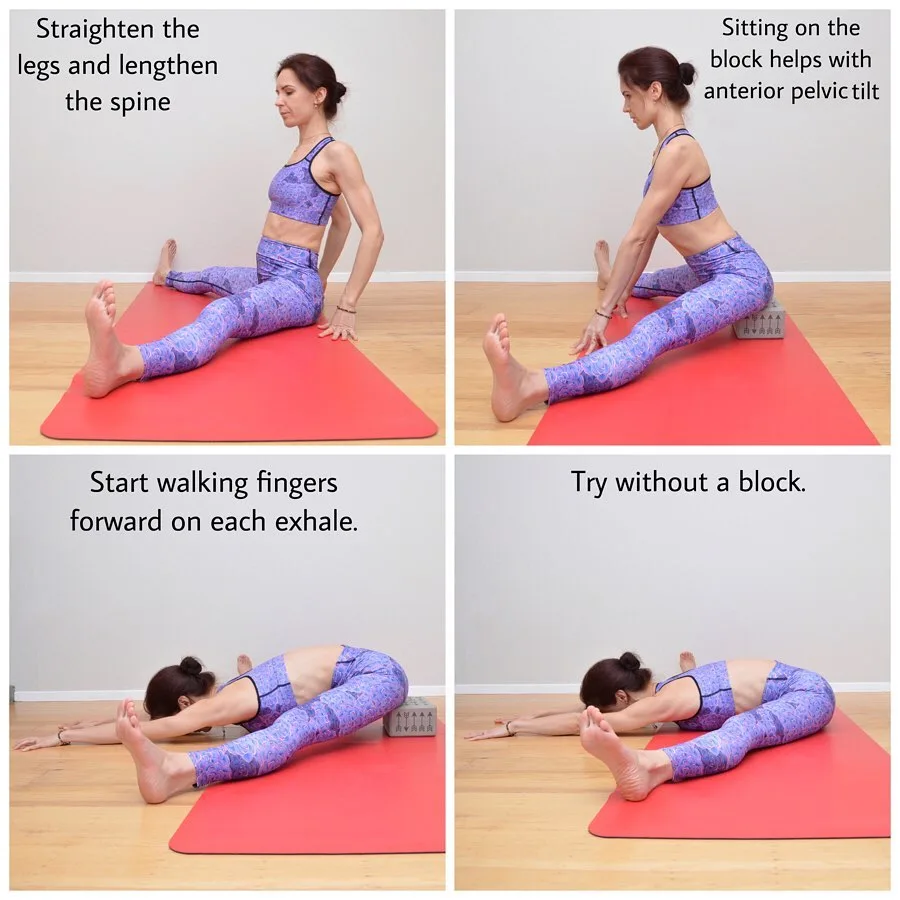Upavistha konasana (oo-pah-VEESH-tah cone-AHS-ah-nah) — Wide Angle Seated Forward Bend pose is an intense leg stretching yoga pose as well as a soothing pose, it’s depending on the style and intention of your practice.
The style of yin and restorative will often provide a comfort variation with the use of props to support minimal effort. In more active exercises such as vinyasa, the pose can be actively used to stretch and build warmth.
Upavistha Konasana — Wide Angle Seated Forward Bend Pose is an excellent preparation mostly for the seated forward bends, twists, and wide-leg standing yoga poses.
This sitting pose stretches the leg muscles (hamstrings and groins), while strengthening the back muscles (supporting muscles of your spine).
In this pose, Upavistha konasana — Wide Angle Seated Forward Bend, you need to maintain a neutral spine, not too much curve, especially in the lower back. To avoid any pain and discomfort, focus on lengthening your spine as you lean forward.
Experts said that Upavistha konasana — Wide Angle Seated Forward Bend Pose help to improve your posture and promote ease and comfort in your body.
When you perform this pose, your legs are rooted in the earth, the spinal column relaxes, and your brain becomes calm.
Continue read this article see what this incredible Upavistha konasana — Wide Angle Seated Forward Bend yoga pose can do to you.
| Know as: | Seated Straddle Pose, Upavistha Konasana, Seated Wide Legged Straddle, Wide Angle Seated Forward Bend Pose, Open Angle Pose, Spread Leg Forward Fold Pose |
| Sanskrit name: | उपविष्ठ कोणासन |
| IAST: | Upaviṣṭa Koṇāsana |
| Pronunciation: | oo-pah-VEESH-tah cone-AHS-ah-nah |
| Level: | Intermediate |
| Type: | Forward-Bend, Hip opener, Seated pose |
| Total time: | 60 seconds to 5 minutes |
| Drishti: | Forward; On the floor, directly under nose |
| Chakra: | Swadisthana Chakra, Muladhara Chakra |
| Focus: | Legs, spine |
| Indications: | Detoxify kidneys, Arthritis |
| Counterposes: | Knees-to-Chest (Apanasana), Gomukhasana (Cow face pose), Sukhasana (Easy pose), Paschimottanasana (Seated forward fold) |
| Preparatory Poses: | Baddha Konasana (Cobblers pose), Prasarita padottanasana (Wide-legged forward fold), Supta padangusthasana (Reclined hand to foot) |
| Follow-up poses: | Kurmasana (Tortoise pose), Malasana (Garland pose) |
| Contraindications: | Modification for lower back injury, Groin or hamstring injury, Low blood pressure |
Note: Individuals with lower back injuries should sit on a folded blanket and focus on keeping their torso upright.
Benefits of Upavistha konasana — Wide Angle Seated Forward Bend Pose
Muscles: Muscle strength is tested on the legs, arms and wrists. This strength further improves flexibility of joints and muscles. Along with the right stretch of the hips, quadriceps, hamstrings, calves, knees, shoulders, chest, upper abdominal arms, helps to improve the flexibility of these muscles.
Digestion: The expansion of the stomach area and the muscles around the stomach enhances the digestive system, eliminates problems related to constipation, other digestive disorders, and indigestion.
Spine: The subcutaneous conasons stretch the muscles around the spine. The use of core muscles expands the lower backbone, sacrum, strengthening back muscles. The chest and shoulders also make the upper back muscles and spine strong.
Efficiency: It helps in improving the efficiency of internal organs, stimulates nerves and increases the circulation of blood to the internal organs of the body which in turn enhances their functionality.
Reproductive organs: Upavistha konasana — Wide Angle Seated Forward Bend helps massage the reproductive organs and pelvic muscles and cures any form of menstrual disorders.
Fat: Upavistha konasana — Wide Angle Seated Forward Bend works well in reducing fat around legs, hands, abdomen and neck. The toning of the body is gradual with various muscle stretches.
Therapeutic application: This pose is considered effective for treating arthritis and provides relief from pain. This pose also helps in reducing the pain of sciatica to a great extent. It also helps to detox the kidneys which ensures their smooth functioning and a healthy body.
Awareness: As the Upavistha konasana — Wide Angle Seated Forward Bend focus on the inner thigh muscles and spine (which are considered to be the most rigid parts of the body), the posture must be in sync with the motion of the body. Therefore it gives the body a place for concentration and peace of mind along with the breath.
- Mental Benefits:
- Relieves stress
- Relieves anxiety
- Reduces mild depression
- Soothes the nervous system
Step-by-step Upavistha Konasana Practice Guides
Upavistha Konasana
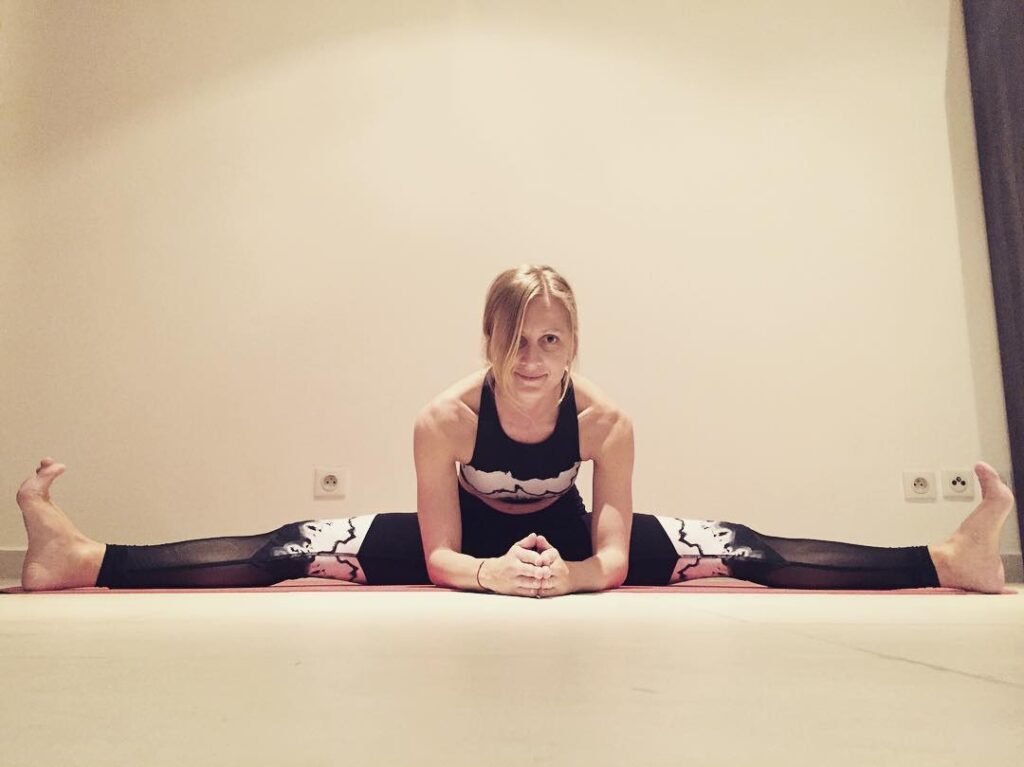
Before practicing this yoga pose you should make sure to keep your stomach and intestines empty. Make you have your meal at least four hours before doing this pose so that your food is digested, and you have enough energy during practice.
- Begin by getting into Dandasana (Staff Pose): sit down on the ground and stretch the legs straight forward, flexing your ankles and bending your toes back toward the torso, which is suspended straight and tall, rising from your hips to the sky.
- Angle the body back slightly, using your hands to support yourself, and open your legs so that the pubis and apex form a 90-degree angle. Raise yourself up on your hands and move the hips forward so that you can widen your legs by 20 degrees.
- Turn the thighs outward and push them into the ground so that your kneecaps are pointed straight up. Press the balls of the feet into the ground to stretch the soles of your feet.
- Keeping your thighs pinned to the ground and kneecaps stable, gently stretch your hands between the legs, moving them as far forward as you can, as if you were moving into a forward bend. Focus on moving away from the hip joints and keeping the front of your body long. Avoid bending at your waist; instead bend from the hips.
- Try to increase the length of the stretch each time as you exhale. Keep lengthening the stretch with each exhale, until you can stretch no farther in comfort.
- Remain in this pose for at least 60 seconds. To release yourself from this pose, inhale, and raise your body up, keeping it long.
Open Angle Pose — Upavistha Konasana
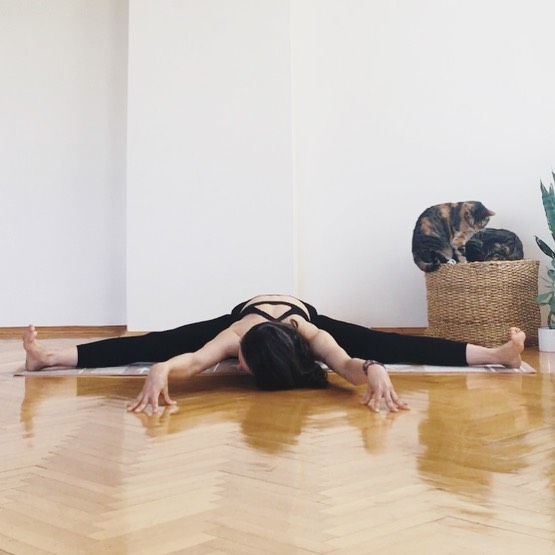
Step-1
Sit with your legs stretched out. Press your fingers into the ground and lift your spine up.
Step-2
Widen your legs and turn them inward so that your feet and knees are facing straight up. With your hands, manually twist the meat of your thighs inward (the worm goes down) and widen your pelvic floor by moving the meat of your buttocks to the side and back. Spread your toes. Bring your hands behind your back and press your fingers down. Tilt your sacrum forward to create a natural curve in your lower back and extend from the core of your pelvis to the top of your head.
Step-3
Maintain the curve in your lower back. Inhale, lengthen your spine, and bring your hands forward over your fingertips. Keep your thigh worms firmly on the ground; Exhale through your legs from your lower abdomen and spread your toes. Press your fingers down and pull your hands back toward your body against the resistance of the floor. With your hands, pull the muscles up from your arms and bring your shoulder blades to your back.
Step-4
Inhale and lengthen through the crown of your head from the core of your pelvis. Exhale, bend your elbows to the sides, and bring your torso forward, moving your heart forward. If you are able to keep your spine stretched, you can rest your forehead on the ground. Lengthen and open the front of the body. Continue to pull your shoulder blades back into your shoulders with your fingers to help plant your back. Lift your elbows and the fronts of your shoulders and draw your shoulder blades more deeply into your back. Stay in the pose up to 60 seconds, then release.
Spread Leg Forward Fold or Seated Straddle Pose or Upavista Konasana
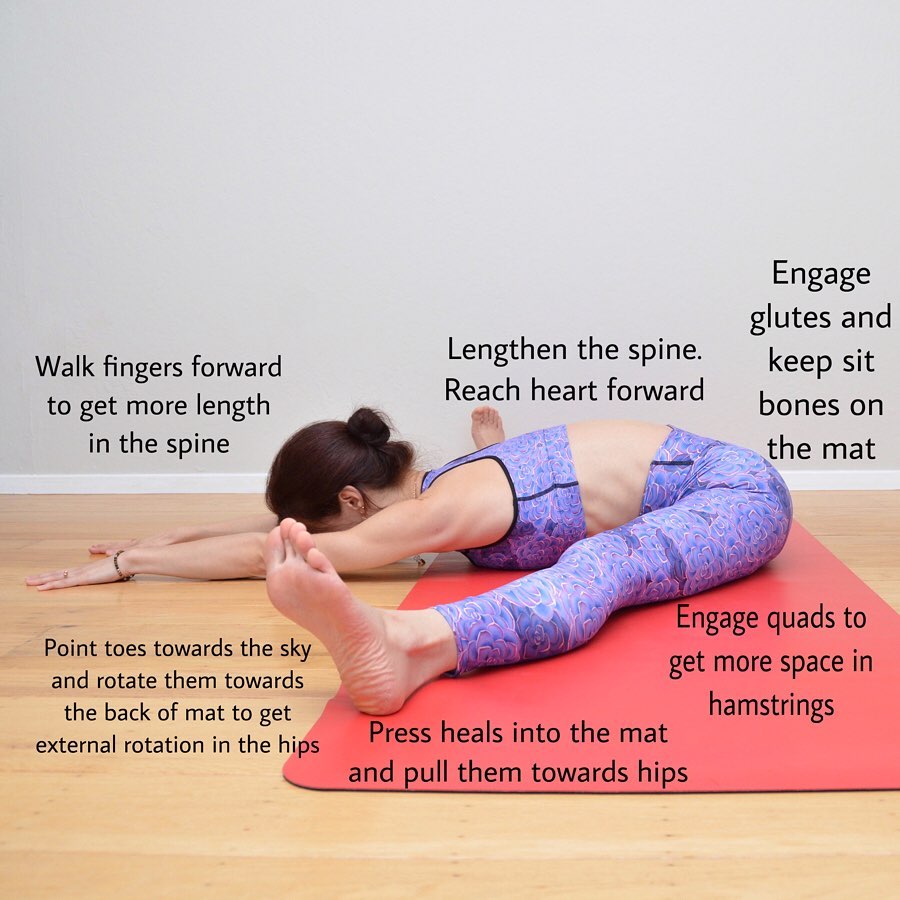
Step-1
Sit on the floor with your legs extended. Place one hand on the floor in front of you, one hand on the floor behind you, then lift your hips up and forward to your comfortable maximum. Then use your hands to pull the buttock muscles back so that your sit bones meet the floor.
Step-2
sit tall Establish the foot lines first. Rotate the feet in or out until the kneecaps are facing the ceiling and the inner sides of your feet are perpendicular. Stay in the center of the back of each heel. Press the back of each thigh firmly into the floor, extending the heel away from you, then extending your toes and pressing outward through the ball of each foot.
Step-3
Align your torso and extend your core. First, bring your lower back forward across your body so that your spine is straight, not rounded. Then lift your chest up from the pelvis, roll the shoulders back, pulling the shoulder blades gently down, and then bring the navel back toward the spine. Namaste, bring your palms together in prayer position, and then lengthen your core by straightening the sit bones and lowering the crown of your head. If you like, close your eyes, and become more grounded, focused. Consciously establish your awareness now. Breathe smoothly. Let your face become soft. Stay here until you are ready to move on.
Step-4
Lean forward and place the hands on the floor. Keep the hands shoulder-width apart and spread your fingers. Rest your palms on the floor. Then tuck the buttocks back and lower yourself into squat dog on the front edge of the sit bones. This will help you move forward in the pose.
Step-5
As you inhale, bring your lower back forward, press down the back of your thighs and lift the front of your body. raise your arms; Don’t sink into the shoulders. Lengthen the front part of your body.
Step-6
As you exhale, slide your hands forward into the pose. Slide your hands forward until you see a new edge, then stop. Do not allow your feet to roll in or out when turning forward; Kneeling should continue to face the ceiling. Wait for these new stretch sensations to subside, then slide your hands forward and bend them deeply. Maintain maximum extension from coccyx to fontanel to fingers. Breathe smoothly.
Step-7
Move slowly, edge to edge; To slide, stop, slide, stop. Do not bend as deeply as you can at once. Stop when you feel each new intermediate edge, and wait for the stretch to subside slightly before turning deeper. Do this over and over again until you can no longer slide your hands forward or drop your spine forward. Eventually your torso—abdomen, chest and forehead—will rest comfortably on the floor.
Step-8
Relax, breathe slowly. Feel the movement of the breath wave through your body. This is a cute pose. Stay here for more than 60 seconds (up to 5 minutes).
Step-9
To come out of the pose. Move your hands backwards and inhale as you return to the sitting position. Bring your palms together in Namaste, close your eyes and experience the effects of the pose.
Wide Angle Seated Forward Bend Pose — Upavistha Konasana
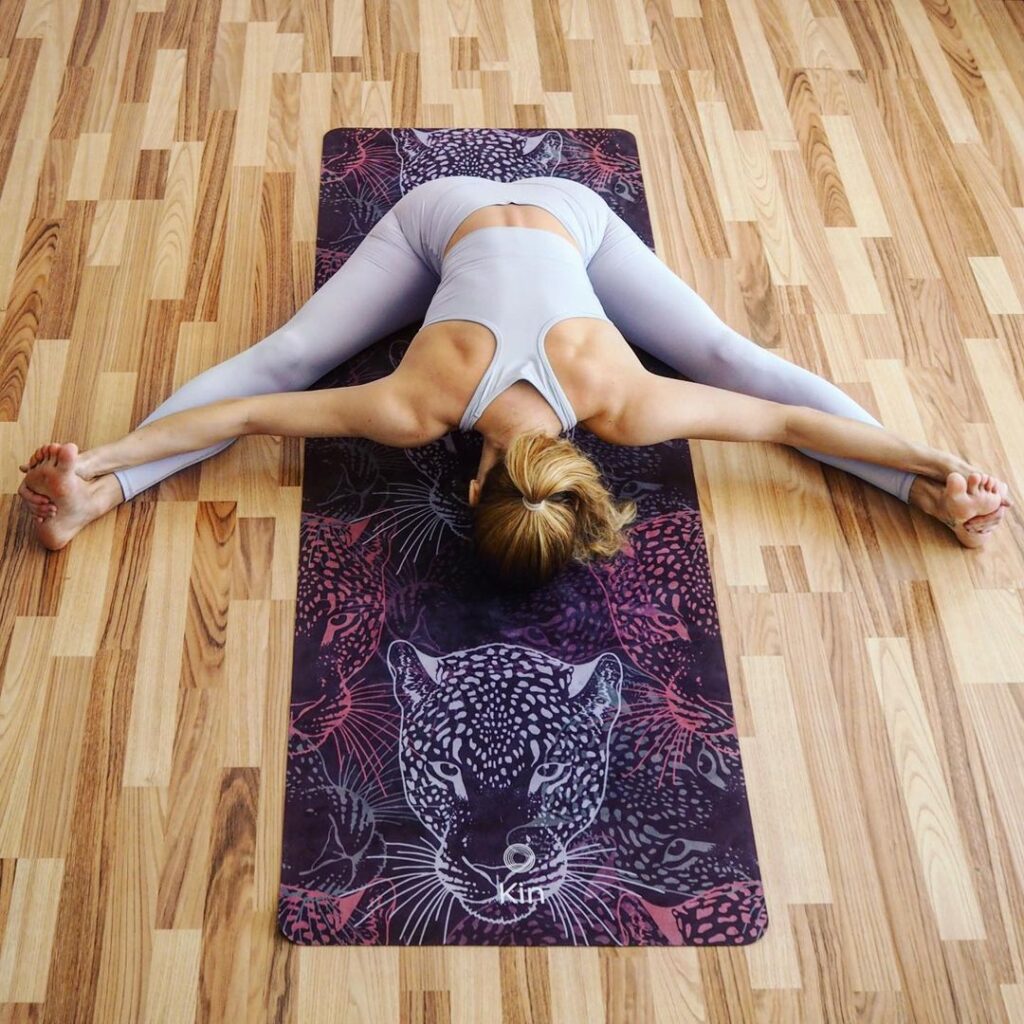
- Begin by connecting the upper and lower ends. If you can’t reach your feet with your hands, use a belt.
- Bend the knees to release the hamstrings at their insertion on the lower legs. Pull the trunk down toward the floor. It moves up and back to the origin of the hamstrings at the ischial tuberosities, loosening these muscles created by flexing the knees.
- Then straighten the knees to bring the hamstrings to length at their insertion, and feel the stretch. Bend your elbows to pull yourself forward.
- As you gain flexibility, toss the belt to one side and reach forward to lift the legs, bending the knees once again to release the hamstrings.
- Grip tightly with hands, and then straighten knees to pull torso forward.
- Plan to get out of Upavistha Konasana by bending the knees. Then consciously engage the lower back muscles to sit. Use the hands to bring the feet back to the midline, and perform Dandasana.
- It balances the acute hip abduction and trunk flexion of Wide Angle Seated Forward Bend Pose with joint and mild spinal extension, respectively. First, stabilize your body and come out of this pose with grace and control.
Step-by-step Anatomy Engaging Techniques
Step-1
- Once you are in the general form of the posture, use your knowledge of biomechanics to deepen it in a precise and careful manner. Surprising energetic openings can take place in millimeters obtained on the physical level.
- For example, when your psoas is in a fully contracted state, it cannot generate additional force to flex your trunk further. It must first be taken to length to regain the shrinkage capacity.
- Achieve this length by engaging your rectus abdominis to flex the lumbar spine. Then contract your psoas to draw your trunk deeper into the pose.
- Your adductors longus and brevis and your pectineus are synergistic of the psoas for hip flexion. To activate these muscles, fix the feet on the mat and try to “scrub” them towards each other.
- The mat keeps your feet from moving, but the action engages your hip flexors. Feel how you go deeper into the posture with this cue.
Step-2
- Straighten your knees and draw your kneecaps up while contracting the quadriceps. It lengthens your hamstrings from their insertion on your lower legs and also stimulates reciprocal inhibition of these muscles, allowing them to relax. Give them rest consciously too.
- Engage your gluteus medius and tensor fascia lata to draw the legs away from the midline (abduction).
- Note that when you stretch a muscle, it pulls your bone at its insertion. This is why stretching your gluteus maximus often results in outward rotation of your thigh. Counter this by turning your thighs inward so that your kneecaps are facing up.
- Remember that your hip abductors, tensor fascia lata and gluteus medius also internally rotate your thighs. Engage them to make this action. Your tensor fascia lata synergizes your quadriceps to straighten your knees.
Step-3
Elevate the soles of your feet by tilting the feet outward, activating your peroneus longus and brevis muscles. Contract your long and short toe extensors to lift your toes. Mobilize the arches by engaging the muscles at the back of the tibialis, and feel how these actions combine to stabilize your ankles and open the soles of your feet.
Step-4
- Hold your feet firmly and try to turn your palms up. It engages your supinator and biceps muscles.
- When you won’t actually move your hands, you’ll create a rotational force that will draw you that millimeter or two deeper into the pose.
- Flex your elbows by contracting your biceps and brachialis muscles. Note that your biceps also supinate your forearms.
- Flex your wrists. Hold your legs tightly onto your feet and try to lift your hands straight up from your shoulders. Your hands won’t move, but this action engages your lateral and anterior parts of your deltoids and flexes your trunk deeper.
- Finally, use your lower trapezius to draw your shoulders away from the ears, and feel how this opens your chest further.
Modification
If you are doing Upavistha konasana — Wide Angle Seated Forward Bend easily then modify the pose and go for changes. On the off chance that you need to increase range, you should move the position and reach your huge toe (right to left and left to left) as you move. Rotate your fingers around the toes and pull the heavy toe when you bend. As you do Upavistha konasana — Wide Angle Seated Forward Bend, you should push through the base of the toes to keep the outer and inside piece of your lower legs. Bend your elbows on the sides, and lift them off the floor as your middle touches the ground.
Science behind Upavistha konasana — Wide Angle Seated Forward Bend
When you go into this intense stretch, your thoughts and feelings are also stimulated. Although this pose looks simple, the mental thoughts resulting from it can be quite enlightening. They say that the conflict between who you really are and what you think is called ego. This conflict often causes a lot of grief. But the best thing is that this pain can be avoided. To pose in a way that is difficult in a way that urges you to go deeper and makes you aware of who you really are, how much you can push yourself, breaks the ego is. You become humble and grounded because the physical and mental challenge of this asana motivates you to break out of your prejudices. Move slowly and carefully as you allow your brain and muscles to open up in the process.
Safety and precautions
Upavistha konasana — Wide Angle Seated Forward Bend puts a lot of pressure on your inner thighs and behind your knees. If you find this pressure unbearable, it is recommended that you miss this posture.
In the case of a tear in your groin and hamstring area, it is recommended that you do not practice Upavistha konasana — Wide Angle Seated Forward Bend. It can cause problems in the future as a large number of lower back injuries and pregnancy conditions.
Use a folded blanket to sit if you are experiencing lower back pain during this Upavistha konasana — Wide Angle Seated Forward Bend. Widen your legs as much as possible.
Note: People with herniated discs should consult a doctor before performing this yoga asana.
Bottom line
Compare Upavistha Konasana with Baddha Konasana (Bound Angle Pose) and Paschimottanasana (Intense Dorsal Stretch). See the similarities and differences that make each pose unique in form and function.
For example, Bound Angle Pose flexes, abducts and externally rotates the hips. Although Upavistha Konasana is similar in this respect, the knees are extended and the trunk moves forward as in Intense Dorsal Stretch.
Note that when the hips are fully bent, as in Upavistha Konasana, the principal inducers of this action are in a state of active insufficiency; That is, the contractile elements of the pose and its synergists cannot generate the significant increased power to deepen the pose. However, you can take advantage of the psoas muscle being polyarticular (crossing several joints); It runs from the lumbar spine and to insert on the sacroiliac joint and the femur in front of the pelvis. Engage the abdominals to slightly round the back; This lengthens the psoas major to the point where contracting it will generate force to flex the hips further. Use the hands to fix your hips in this new, more deeply flexed position, and then activate the erector spinae and quadratus lumborum muscles to arch your lower back.
To review, when a muscle is fully contracted, it cannot generate much force to deepen the posture. However, polyarticular muscles such as your psoas can move multiple joints along their length. This means that they can be extended at one point and then contracted at another. Additionally, Upavistha Konasana engages the arms and legs to maintain and increase the flexibility of the hip and torso.


